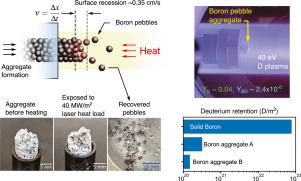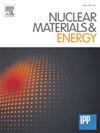一种用于磁聚变装置中可再生等离子体表面的氮化硼-硼卵石聚集体材料的评价
IF 2.7
2区 物理与天体物理
Q1 NUCLEAR SCIENCE & TECHNOLOGY
引用次数: 0
摘要
我们展示了一种新的可再生硼聚集体材料,它可以承受40 MW m-2的热负荷而不需要冷却,并且具有低于100 Torr-L/s/m2的低升华和0.04的溅射产率,类似于固体硼。氘(D)的保留量为3.2 × 1020 D/m2,比固体硼少200倍,比碳少100倍,在相似的通量和能量下与钨相当。材料在高热负荷下以0.35 cm/s的速率脱落,将冷却的表面暴露在等离子体中,允许从等离子体中去除热量和提取氚,从而消除了冷却通道的需要。由于材料可以以1厘米/秒的速度从糊状物中挤出,因此可以补偿这种衰退率。本文章由计算机程序翻译,如有差异,请以英文原文为准。

Evaluation of a boron nitride–boron pebble aggregate material for renewable plasma-facing surfaces in magnetic fusion devices
We demonstrate a new renewable boron aggregate material that can withstand heat loads of 40 MW m-2 without cooling and featuring low sublimation of below 100 Torr-L/s/m2 and sputtering yield of 0.04 from 40 eV D, similar to solid boron. The retention of deuterium (D) is 3.2 × 1020 D/m2, 200 less than solid boron, 100 less than carbon, and comparable to tungsten at similar fluence and energy. The material sheds under high heat loads, at a rate of 0.35 cm/s, exposing the cool surface to the plasma, allowing heat removal and tritium extraction away from the plasma and eliminating the need for cooling channels. This recession rate can be compensated for, as the material can be extruded from a paste at a rate of 1 cm/s.
求助全文
通过发布文献求助,成功后即可免费获取论文全文。
去求助
来源期刊

Nuclear Materials and Energy
Materials Science-Materials Science (miscellaneous)
CiteScore
3.70
自引率
15.40%
发文量
175
审稿时长
20 weeks
期刊介绍:
The open-access journal Nuclear Materials and Energy is devoted to the growing field of research for material application in the production of nuclear energy. Nuclear Materials and Energy publishes original research articles of up to 6 pages in length.
 求助内容:
求助内容: 应助结果提醒方式:
应助结果提醒方式:


